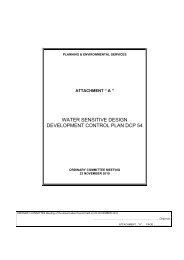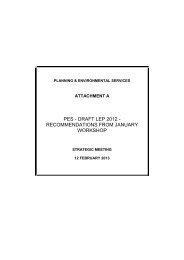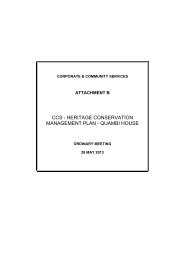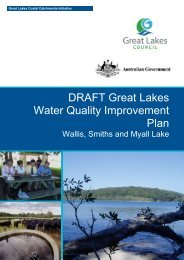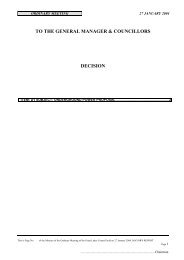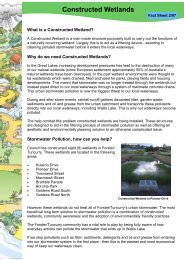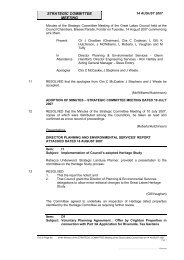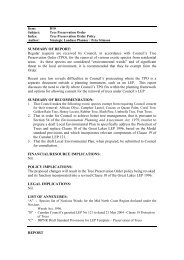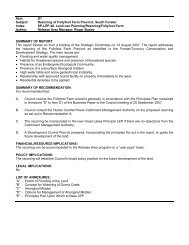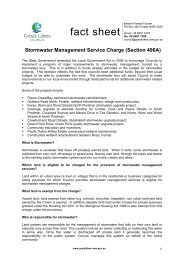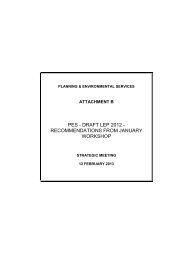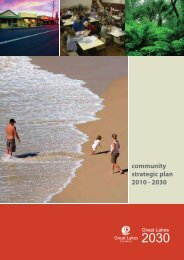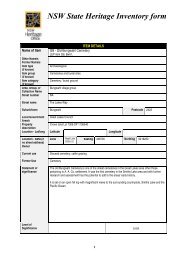13.2 The Wallis Lake Estuary Management Committee - Great Lakes ...
13.2 The Wallis Lake Estuary Management Committee - Great Lakes ...
13.2 The Wallis Lake Estuary Management Committee - Great Lakes ...
Create successful ePaper yourself
Turn your PDF publications into a flip-book with our unique Google optimized e-Paper software.
<strong>Wallis</strong> <strong>Lake</strong> <strong>Estuary</strong> <strong>Management</strong> Plan<br />
M.7<br />
<strong>Management</strong> Area D, E<br />
<strong>Management</strong> Objective<br />
Reduce the impacts of stock in the riparian zone<br />
Action<br />
No<br />
M.7.1<br />
M.7.2<br />
M.7.3<br />
Action<br />
Encourage and facilitate sustainable stock management practices in riparian<br />
zones<br />
Evaluate the findings of the Crown Land assessment at <strong>Wallis</strong> <strong>Lake</strong> and the<br />
Wallamba River<br />
Consider the complete removal of stock from riparian zones in the foreshore<br />
Crown Reserve pending the results from M.7.2<br />
Indicative<br />
Cost<br />
Priority Responsibilities Progress<br />
Staff time Immediate (B2) Lands, GLC,<br />
DIPNR<br />
Staff time Immediate (B2) Lands, GLC,<br />
DIPNR<br />
TBD Immediate (B2) Lands, GLC,<br />
DIPNR<br />
Comments<br />
Fencing and providing alternative shade, as well as promoting revegetation/regeneration of riverbanks with native indigenous trees, shrubs and grasses can reduce the impact of<br />
stock in the riparian zone. By then employing a controlled ‘pulse grazing’ technique, weeds can be effectively controlled. <strong>The</strong> impacts of stock permanently grazing in the riparian<br />
zone can be severe and through grazing and trampling can:<br />
• deplete the banks of reinforcing vegetation making banks more prone to erosion<br />
• prevent young vegetation from growing<br />
• directly expose bank material to erosion<br />
• compact soil reducing infiltration, root growth and overall plant production<br />
• diminish the overall diversity of plant species and provide more favourable conditions for weeds, and<br />
• contribute excessive nutrients to waterways by concentrating nutrients derived from cattle dung.<br />
[Lower Wallamba River rivercare plan]<br />
<strong>The</strong> Department of Lands is currently conducting a comprehensive Crown Lands assessment. This review could see the development of terms and conditions attached to permits<br />
and leases to ensure the protection of ecologically significant riparian areas. It is recommended that based on the results of this assessment, the complete removal of stock from<br />
these areas in the foreshore Crown Reserve * be considered.<br />
Implementation of the Lower Wallamba River rivercare plan (action M.6.1) will also aid considerably in achieving this management objective.<br />
* Crown Reserve extends approximately 30 m around the foreshore of the <strong>Wallis</strong> <strong>Lake</strong> estuary<br />
74




